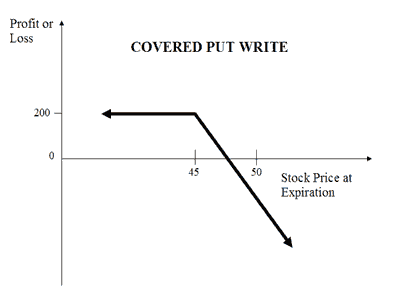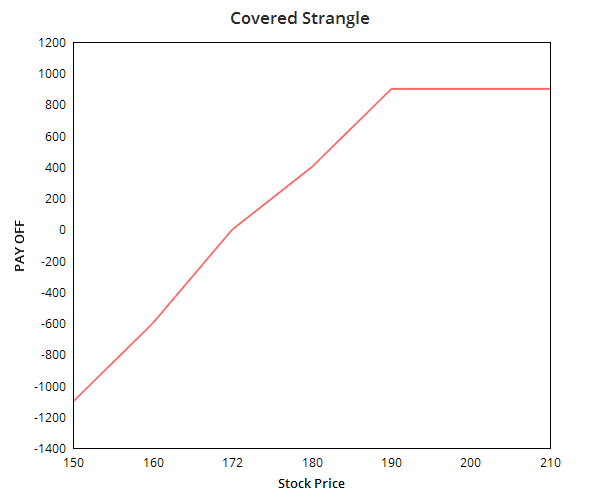 Zerodha (Trading & Demat Account)
Zerodha (Trading & Demat Account)
FREE Equity Delivery and MF
Flat ₹20/trade Intra-day/F&O
 Zerodha (Trading & Demat Account)
Zerodha (Trading & Demat Account)
FREE Equity Delivery and MF
Flat ₹20/trade Intra-day/F&O

|
|
Compare Covered Put (Married Put) and Covered Strangle options trading strategies. Find similarities and differences between Covered Put (Married Put) and Covered Strangle strategies. Find the best options trading strategy for your trading needs.
| Covered Put (Married Put) | Covered Strangle | |
|---|---|---|
 |
 |
|
| About Strategy | The Covered Put is a neutral to bearish market view and expects the price of the underlying to remain range bound or go down. In this strategy, while shorting shares (or futures), you also sell a Put Option (ATM or slight OTM) to cover for any unexpected rise in the price of the shares. This strategy is also known as Married Put strategy or writing covered put strategy. The risk is unlimited while the reward is limited in this strategy. How to use a Protective Call trading strategy? The usual Covered Put looks like as below for State Bank of India (SBI) Shares which are currently traded at Rs 275 (SBI Spot Price): Covered Put Orders - SBI Stock OrdersSBI Strike Price Sell Underlying SharesSell 100 SBI Shares ... Read More | The covered strangle option strategy is a bullish strategy. The strategy is created by owning or buying a stock and selling an OTM Call and OTM Put. It is called covered strangle because the upside risk of the strangle is covered or minimized. The strategy is perfect to use when you are prepared to sell the holding or bought shares at a higher price if the market moves up but would also is ready to buy more shares if the market moves downwards. The profit and in this strategy is unlimited while the risk is only on the downside. |
| Market View | Bearish | Bullish |
| Strategy Level | Advance | Advance |
| Options Type | Put + Underlying | Call + Put + Underlying |
| Number of Positions | 2 | 3 |
| Risk Profile | Unlimited | Limited |
| Reward Profile | Limited | Limited |
| Breakeven Point | Futures Price + Premium Received | two break-even points |
| Covered Put (Married Put) | Covered Strangle | |
|---|---|---|
| When to use? | The Covered Put works well when the market is moderately Bearish |
A covered strangle strategy can be used when you are bullish on the market but also want to cover any downside risk. You are prepared to sell the shares on profit but are also willing to buy more shares in case the prices fall. |
| Market View | Bearish When you are expecting a moderate drop in the price and volatility of the underlying. |
Bullish The Strategy is perfect to apply when you're bullish on the market and expecting less volatility in the market. |
| Action | Sell Underlying Sell OTM Put Option Suppose SBI is trading at 300. You believe that the price will remain range bound or mildly drop. The covered put allows you to benefit from this market view. In this strategy, you sell the underlying and also sell a Put Option of the underlying and receive the premium. You will benefit from drop in prices of SBI, the Put Option will minimize your risks. If there is no change in price then you keep the premium received as profit. |
Buy 100 shares + Sell OTM Call +Sell OTM Put The covered strangle options strategy can be executed by buying 100 shares of a stock while simultaneously selling an OTM Put and Call of the same the stock and similar expiration date. |
| Breakeven Point | Futures Price + Premium Received The break-even point is achieved when the price of the underlying is equal to the total of the sale price of underlying and premium received. |
two break-even points There are 2 break-even points in the covered strangle strategy. One is the Upper break even point which is the sum of strike price of the Call option and premium received while the other is the lower break-even point which is the difference strike price of short Put and premium received. |
| Covered Put (Married Put) | Covered Strangle | |
|---|---|---|
| Risks | Unlimited The Maximum Loss is Unlimited as the price of the underlying can theoretically go up to any extent. Loss = Price of Underlying - Sale Price of Underlying - Premium Received |
Limited The risk on this strategy is only on the downside when the price moves below the strike price of the Put option. |
| Rewards | Limited The maximum profit is limited to the premiums received. The profit happens when the price of the underlying moves above strike price of Short Put. |
Limited The maximum profit on this strategy happens when the stock price is above the call price on expiry. The profit is the total of the gain from buying/selling stocks and net premium received on selling options. |
| Maximum Profit Scenario | Underlying goes down and Options exercised |
You will earn the maximum profit when the price of the stock is above the Call option strike price on expiry. You will be assigned on the Call option, would be able to sell holding shares on profit while retaining the premiums received while selling the options. |
| Maximum Loss Scenario | Underlying goes up and Options exercised |
The maximum loss would be when the stock price falls drastically and turns worthless. The premiums received while selling the options will compensate for some of the loss. |
| Covered Put (Married Put) | Covered Strangle | |
|---|---|---|
| Advantages | Its an income generation strategy in a neutral or Bearish market. Also allows you to benefit from fall in prices, range bound movements or mild increase. |
|
| Disadvantage | The risks can be huge if the prices increases steeply. |
|
| Simillar Strategies | Bear Put Spread, Bear Call Spread | Long Strangle, Short Strangle |

Add a public comment...

FREE Intraday Trading (Eq, F&O)
Flat ₹20 Per Trade in F&O
|
|